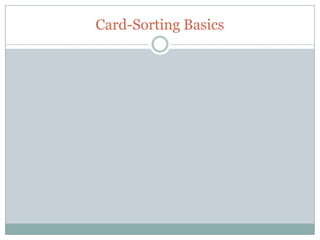Card sorting
•Transferir como PPTX, PDF•
2 gostaram•625 visualizações
Denunciar
Compartilhar
Denunciar
Compartilhar

Recomendados
Mais conteúdo relacionado
Semelhante a Card sorting
Semelhante a Card sorting (20)
No Interface? No Problem: Applying HCD Agile to Data Projects (Righi)

No Interface? No Problem: Applying HCD Agile to Data Projects (Righi)
What is UX and Why should I care in Line of Business Applications?

What is UX and Why should I care in Line of Business Applications?
Information Architecture Techniques and Best Practices

Information Architecture Techniques and Best Practices
Último
Último (20)
Boost Fertility New Invention Ups Success Rates.pdf

Boost Fertility New Invention Ups Success Rates.pdf
Apidays New York 2024 - Passkeys: Developing APIs to enable passwordless auth...

Apidays New York 2024 - Passkeys: Developing APIs to enable passwordless auth...
Vector Search -An Introduction in Oracle Database 23ai.pptx

Vector Search -An Introduction in Oracle Database 23ai.pptx
DEV meet-up UiPath Document Understanding May 7 2024 Amsterdam

DEV meet-up UiPath Document Understanding May 7 2024 Amsterdam
Finding Java's Hidden Performance Traps @ DevoxxUK 2024

Finding Java's Hidden Performance Traps @ DevoxxUK 2024
ProductAnonymous-April2024-WinProductDiscovery-MelissaKlemke

ProductAnonymous-April2024-WinProductDiscovery-MelissaKlemke
CNIC Information System with Pakdata Cf In Pakistan

CNIC Information System with Pakdata Cf In Pakistan
Repurposing LNG terminals for Hydrogen Ammonia: Feasibility and Cost Saving

Repurposing LNG terminals for Hydrogen Ammonia: Feasibility and Cost Saving
Web Form Automation for Bonterra Impact Management (fka Social Solutions Apri...

Web Form Automation for Bonterra Impact Management (fka Social Solutions Apri...
"I see eyes in my soup": How Delivery Hero implemented the safety system for ...

"I see eyes in my soup": How Delivery Hero implemented the safety system for ...
Cloud Frontiers: A Deep Dive into Serverless Spatial Data and FME

Cloud Frontiers: A Deep Dive into Serverless Spatial Data and FME
Introduction to Multilingual Retrieval Augmented Generation (RAG)

Introduction to Multilingual Retrieval Augmented Generation (RAG)
EMPOWERMENT TECHNOLOGY GRADE 11 QUARTER 2 REVIEWER

EMPOWERMENT TECHNOLOGY GRADE 11 QUARTER 2 REVIEWER
Apidays New York 2024 - The value of a flexible API Management solution for O...

Apidays New York 2024 - The value of a flexible API Management solution for O...
Connector Corner: Accelerate revenue generation using UiPath API-centric busi...

Connector Corner: Accelerate revenue generation using UiPath API-centric busi...
Card sorting
- 2. First Rule of UCD Thou are not thy USER!
- 3. What is card-sorting? Card sorting is a common technique within user- centred design (UCD) methodologies. All too often information on websites is organized according to stakeholder perceptions. As User Experience professionals, our role is to bring focus back onto the perceptions and desires of the users to provide an optimal balance between the two. Card sorting is an established technique often used to help structure, organize, and generally improve the “findability of content or functionality” on a website, (Rubin and Chisnell, 2008, p. 18).
- 4. Before recently, we made design decisions based on just two things: what we thought was awesome and what the client wanted to see. There was no science behind what we did. We did it because the results looked good, because they were creative (so we thought) and because that was what our clients wanted.
- 6. What is UCD?
- 7. User Centered Design UCD is a methodology Usability is an outcome of UCD practices This standard (ISO 13407: Human-centered design process) defines a general process for including human-centered activities throughout a development life-cycle, but does not specify exact methods.
- 8. UCD seeks to answer questions such as: Who are the users of this 'thing'? What are the users‟ tasks and goals? What are the users‟ experience levels with this thing, and things like it? What functions do the users need from this thing? What information might the users need, and in what form do they need it? How do users think this 'thing' should work? How can the design of this „thing‟ facilitate users' cognitive processes?
- 9. What is Information Architecture?
- 10. The term was largely dormant until in 1996 it was seized upon by a couple of library scientists, Lou Rosenfeld and Peter Morville. They used the term to define the work they were doing structuring large- scale websites and intranets. In Information Architecture for the World Wide Web: Designing Large-Scale Web Sites they define information architecture as: The combination of organization, labeling, and navigation schemes within an information system. The structural design of an information space to facilitate task completion and intuitive access to content. The art and science of structuring and classifying web sites and intranets to help people find and manage information. An emerging discipline and community of practice focused on bringing principles of design and architecture to the digital landscape.
- 12. Can use post-it notes 3x5 cards Any type of paper really Pens
- 13. There are two primary methods for performing card sorts. Open Card Sorting: Participants are given cards showing site content with no pre-established groupings. They are asked to sort cards into groups that they feel are appropriate and then describe each group. Open card sorting is useful as input to information structures in new or existing sites and products. Closed Card Sorting: Participants are given cards showing site content with an established initial set of primary groups. Participants are asked to place cards into these pre-established primary groups. Closed card sorting is useful when adding new content to an existing structure, or for gaining additional feedback after an open card sort.
- 14. Website Links http://www.boxesandarrows.com/view/card_sortin g_a_definitive_guide http://www.boxesandarrows.com/view/beyond_car dsorting_free_listing_methods_to_explore_user_c ategorizations
- 15. Sites Info Taken From: http://uxdesign.smashingmagazine.com/2010/10/0 5/what-is-user-experience-design-overview-tools- and-resources/ http://whitneyhess.com/blog/2011/04/23/youre- not-a-user-experience-designer-if/ http://www.masternewmedia.org/how-to-use- personas-in-user-experience-design-and- development-research/ http://www.peterme.com/archives/00000346.html These slides were created for educational purpose and not commercial.